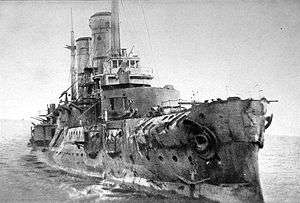Spanish Crisis of 1917
The Crisis of 1917 is a name given by Spanish historians to the events that took place in the summer of 1917 in Spain, prominently three simultaneous challenges that challenged the government and even the same system of the Restoration: a military movement (the Juntas), a political movement (the Parliamentary Assembly of Catalanist orientation that took place in Barcelona), and a social movement (the revolutionary general strike). They coincided with international circumstances particularly critical in that year, possibly one of the most crucial in the entire history. In contrast, world historians not usually use the name for that period of crisis, reserving it for certain specific matters concerning the First World War: the recruiting crisis in Canada and the crisis in the U.S. shipbuilding industry.[1][2]
International conjuncture

In Russia, the February Revolution of 1917 had destroyed the Tsarist autocracy and the Kerensky government tried to build a democratic system while continuing the war against the Central Powers. The growing discontent was being utilized by the Bolsheviks to achieve power in the October Revolution that year.[3]
World War I was going through a phase of uncertainty, with the German advantage on the Eastern Front, but was compensated by the entry of the U.S. into the war, in April 1917.
The crisis in Spain

Economy and Society
The Spanish neutrality in the World War I promoted exports of all products, from raw materials (agricultural and mineral) to certain manufactures of the emerging industrialization concentrated in the textile and Ironworks industries. The balance of trade grew from negative to positive by more than one hundred million pesetas to be five hundred million.[4] The good time for business favored the industrial and commercial middle class, but at the same time inflation was not accompanied by similar increases in wages. While profits achieved extraordinarily important rates of growth, significant decrease was in the standard of living of the masses, mainly the urban and industrial proletariat, which still was that which demonstrated more ability to maintain continuous pressure for wage increases. In the countryside the situation was different: the inflationary impact was greater, but more direct provision of food availability deadened its impact on the peasantry in the case of small landowners and tenants (predominant in the agrarian structure in northern Spain), that may benefit; but not quite the opposite for the landless laborers, the fundamental part of the workforce in the southern half of Spain (especially in Andalusia and Extremadura). The results of the process, already acutely visible in 1917, was a fierce redistribution of national income (both between social classes and among territories), with progressively worsening rural-urban tensions and center-periphery.[5]
Military challenge
The set up of Boards of Defense and a military union movement not covered by the legislation, was a clear challenge to the liberal government of Manuel Garcia Prieto, who, powerless to control, was forced to resign. His replacement, conservative Eduardo Dato, chose to legalize it.
The boards claimed to defend the interests of middle ranking officers, but their vocation to intervene in politics was evident.
One of the issues of greatest ability to mobilize within the army had been its obsession with national unity, clearly manifested from the Catalan satirical attack on the Cu-Cut! (1905), after which the government gave the enactment of the Law of Jurisdictions to satisfy them, that subjected the military justice to the insults, either oral or written, to the unity of the country, the flag and the honor of the army.
References
Works cited
- Balanzá, M. Roig, J. and others (1994) Ibérica. Geografía e Historia de España y de los Países Hispánicos. [Iberia. Geography and History of Spain and Hispanic countries.] Barcelona: Vicens Vives. ISBN 84-316-3480-4.
- Garcia Queipo, Genoveva (1996) El reinado de Alfonso XIII. La modernización fallida. [The reign of Alfonso XIII. Modernization failed.] Madrid: Issues of Today. ISBN 84-7679-318-9.
- Martinez Cuadrado, Miguel (1973) LLa burguesía conservadora (1874-1931). [The conservative middle class (1874-1931).] 7th edition. History of Spain. Madrid: Alianza. 1981. ISBN 84-206-2049-1.
- Tunon de Lara, Manuel (ed.) (1984)Historia de España. [History of Spain.] Barelona: Labor. ISBN 84-335-9420-6 (volumes), volume 8: bourgeois revolution, oligarchy and Constitutionalism (1834-1923), 2nd edition, 1987. ISBN 84-335-9439-7.
Notes
- ↑ Shaw, Amy J (2009), Crisis of conscience: conscientious objection in Canada during the First World War, UBC Press, ISBN 9780774815932
- ↑ William J. Williams (1992) The Wilson Administration and the Shipbuilding Crisis of 1917: Steel Ships and Wooden Steamers, Edwin Mellen Press ISBN 0-7734-9492-8
- ↑ Edward Acton (1990). Rethinking the Russian Revolution. Oxford University Press US. ISBN 978-0-7131-6530-2. Retrieved 29 August 2010.
- ↑ Genoveva Garcia Queipo, op. cit. pg. 18.
- ↑ José Luis García Delgado Proceso inflacionista y política económica. Algunas conclusiones [Inflationary process and policy. Some conclusions in The Spanish economy between 1900 and 1923] in Tunon de Lara (dir). op. cit., pgs. 447-448.